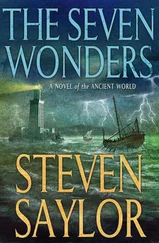Looking up he saw a ship approaching fast. By sheer good luck, James Spink in the Bell Rock pilot boat had come out from Arbroath with post and supplies. As he approached, Spink had seen the terrible dilemma of those on the rock and come to the rescue. This episode left a deep impression on Stevenson. The picture of the men silently standing by the boats awaiting their fate made him acutely aware of his responsibility for their safety and that, on this occasion, only a stroke of luck had averted a terrible catastrophe.
On 5 September 1807, the tide receded late in the day and as the sea was running a heavy swell, making the rowing boats hard to handle, Stevenson decided to cancel the trip to the rock. This proved to be a most fortunate choice as the stiff breeze turned rapidly into a hard gale and would have made rowing back from the rock in the darkness a terrifying, if not fatal, experience. The storm raged all night and the next day; the little lightship was hit by successive waves of such force that for a few seconds, as she met each wave, her rolling and pitching motion stopped, and it felt as though she had broken adrift or was sinking. The skylight in Stevenson’s cabin near the helm was broken and water poured in from the waves, which were crashing on deck. Later in the morning, Stevenson tried to dress but was so violently thrown around in his cabin he gave up.
At two o’clock in the afternoon, an enormous wave struck the ship with such terrifying force that tons of water poured into the berths below, drenching bedding and sloshing as one body from side to side as the ship moved. ‘There was not an individual on board who did not think, at the moment, that the vessel had foundered,’ wrote Stevenson, ‘and was in the act of sinking.’ The fire had been extinguished in the galley and the workmen, in darkness, were deep in prayer, swearing that should they survive, they would never go to sea again. But by the evening the storm had blown itself out and the workmen were grateful to find the crew returning the ship to normal with a fire in the galley and bedding dried.
By mid-September, the bad storms that had prevented work on the rock were replaced by quiet seas and kind weather in which Stevenson hoped to raise the six main beams of the beacon house. It was essential to get the 50-foot beams up and secure quickly as a day or two of bad weather could destroy any work left unfinished and autumn was approaching. More men were recruited from Arbroath. There were now as many as 40 carpenters, smiths and masons on Bell Rock. Their first task was to get a 30-foot mast erected to use as a derrick and a winch machine bolted down. The six principal beams – with iron bars and bolts already in place – were rowed on two rafts from Arbroath. In order to get the first four timbers securely in place in the space of one tide, the men worked in teams. They began before the tide was out, labouring deep in water, hoisting the beams into their allotted places. Others bolted them to the iron stanchions already fixed in the rock to a depth of almost twenty inches and yet more men were ready to secure the uprights with wedges made of oak then finally iron.
Every man worked with great intensity before the inevitable returning water claimed the rock. As the waves engulfed them first up to their knees and then their waists, the four main beams were put in place and securely tied to form a cone shape; the timbers were temporarily lashed together with rope at the apex and mortised into a large piece of beechwood. As the last men were leaving, up to their armpits in water, a rousing ‘three cheers’ rang out from the men already in the rowing boats. The beacon was standing bravely above the waves.
Конец ознакомительного фрагмента.
Текст предоставлен ООО «ЛитРес».
Прочитайте эту книгу целиком, купив полную легальную версию на ЛитРес.
Безопасно оплатить книгу можно банковской картой Visa, MasterCard, Maestro, со счета мобильного телефона, с платежного терминала, в салоне МТС или Связной, через PayPal, WebMoney, Яндекс.Деньги, QIWI Кошелек, бонусными картами или другим удобным Вам способом.












